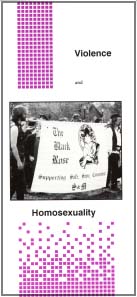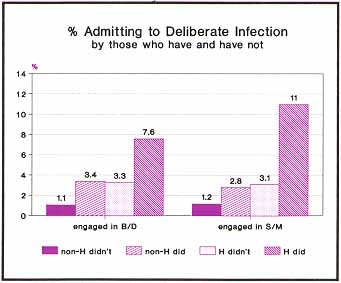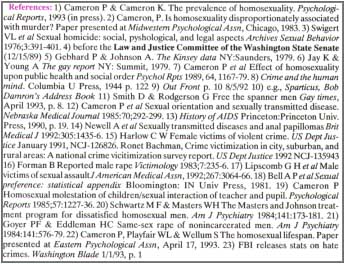By Paul Cameron, Ph. D.
Dr. Cameron is Chairman of the Family Research Institute of Colorado Springs, Colorado USA. Click here for more information about this organization. You may contact him at: Family Research Institute, PO Box 62640, Colorado Springs, CO 80962 USA. Phone number: (303) 681-3113.
 In
1992 two Jeffersonville, Indiana lesbians, aged 17 and 16, abducted a
12-year-old girl whom they accused of trying to "steal a girlfriend." The little
girl was pushed into the trunk of a car, stabbed repeatedly, and beaten with a
heavy metal bar. While still struggling, they poured gasoline on her and set her
ablaze. Later that year a Fort Lauderdale, Florida 14-year-old was convicted of
first-degree murder for helping to kill his 40-year-old father. The father "was
stabbed 45 times and beaten so badly with an iron skillet that the skillet
shattered." The boy confessed that he helped his father’s former homosexual
lover and roommate kill him so he and the 31-year-old "could live together."
In
1992 two Jeffersonville, Indiana lesbians, aged 17 and 16, abducted a
12-year-old girl whom they accused of trying to "steal a girlfriend." The little
girl was pushed into the trunk of a car, stabbed repeatedly, and beaten with a
heavy metal bar. While still struggling, they poured gasoline on her and set her
ablaze. Later that year a Fort Lauderdale, Florida 14-year-old was convicted of
first-degree murder for helping to kill his 40-year-old father. The father "was
stabbed 45 times and beaten so badly with an iron skillet that the skillet
shattered." The boy confessed that he helped his father’s former homosexual
lover and roommate kill him so he and the 31-year-old "could live together."
These murders fit traditional psychiatric opinion: excessive violence is naturally associated with other forms of social pathology. From this perspective, those who rebel against society’s norms – homosexuals, prostitutes, alcoholics, etc. – are more apt to be violent also. Gay leaders reply that they are not pathological, rebellious, or sexually deviant. They contend that gays are gentle, loving people and that the violence they experience proves that they need special ‘hate crime’ laws to protect them from non-homosexual ‘gay bashers.’
Who’s right? Does the excess of violence naturally well up from within a pathological gay subculture or do outsiders direct it toward homosexuals? Keeping in mind that only about 2%—3% of adults are homosexual or bisexual, (1) let's examine varieties of violence.
Murder and Mass Murder
Although the total number of victims dispatched by a given killer is often in doubt, (e.g., homosexual Henry Lucas claimed that he killed 350), it appears that the modern world record for serial killing is held by a Russian homosexual, Andrei Chikatilo, who was convicted in 1992 of raping, murdering and eating parts of at least 21 boys, 17 women and 14 girls. The pathology of eating one’s sexual victims also characterized Milwaukee's Jeffrey Dahmer in 1992. He not only killed 17 young men and boys, but cooked and ate their body parts.
The top six U.S. male serial killers were all gay:
• Donald Harvey claimed 37 victims in Kentucky;
• John Wayne Gacy raped and killed 33 boys in Chicago, burying them under his house and in his yard;
• Patrick Kearney accounted for 32, cutting his victims into small pieces after sex and leaving them in trash bags along the Los Angeles freeways;
• Bruce Davis molested and killed 27 young men and boys in Illinois;
• A gay sex-murder-torture ring (Corll-Henley-Brooks) sent 27 Texas men and boys to their grave; and
• Juan Corona was convicted of murdering 25 migrant workers (he "made love" with their corpses).
Lesbian Aileen Wuornos laid claim in 1992 to "worst female killer" with at least 7 middle-aged male victims. She single-handedly topped the lesbian nurse team of Catherine Wood and Gwen Graham, who had killed 6 convalescent patients in Grand Rapids, Michigan.
The association between serial murder and homosexuality isn’t recent. Two gays compete for the spot of "world’s worst murderer." During the Nazi reign of terror, Auschwitz executioner Ludwig Tiene strangled, crushed, and gnawed boys and young men to death while he raped them. Though his grand total is uncertain, he often murdered as many as 100 a day. Gilles de Rais (Bluebeard) brutally destroyed the lives of 800 boys. Each lad was lured to his home, bathed and fed. Just as the poor boy thought "this is my lucky day," he was raped, then killed by being ripped or cut apart and either burned or eaten.
A study of 518 sexually-tinged mass murders in the U.S. from 1966 to 1983 determined that 350 (68%) of the victims were killed by those who practiced homosexuality and that 19 (44%) of the 43 murderers were bisexuals or homosexuals.(2)
Though probably less than a majority of mass murderers are homosexual, given that no more than 3% of the populace is gay, homosexual murderers show up much more frequently than one would expect (even Richard Speck engaged in homosexuality). Along with serial murder, there appears to be a connection between homosexuality and murder. Evidence from before the gay rights movement is limited. Of 444 homicides in one jurisdiction from 1955-1973, investigators noted 5 clear "sexual motivation" murders. Three of the 5 involved homosexuality and 2 involved heterosexuality. (3)
Probing more deeply into the connection between murder and homosexuality, Jim Warren, who worked as a counselor at the Washington State Corrections Center, did the intake interview for almost all the younger murderers (i.e., under age 36) in the state of Washington from 1971-82 (during the growth of the gay rights movement). He was "probably the only one who examined the entirety of each of their case files." Warren testified (4) that he was struck with how frequently homosexuality turned up in the cases.
Starting with a trickle of 2 or 3 murders/year in 1972 until dozens/year by the 1980s, he noted a recurrent pattern: Although the motive listed in the report was often robbery or theft, "about 50% of the time" it was also associated with homosexuality. Typically, a homosexual would meet someone at a bar or park and invite him to his home. Before the morning, an argument would ensue and he or his visitor would be dead.
Violent Sexual Practices
A substantial minority of homosexuals (between 22% (5) to 37% (6,7) ) indulge in painful or violent sex (e.g., bondage and discipline [B/D], where the partner is physically restrained and mildly tortured, or sadomasochism [S/M], where partners are tortured or hurt during sex). Even in the 1940s, psychiatrist David Abrahamsen (8) noted, "It is well known that homosexual inclinations may be accompanied by sadistic or masochistic tendencies.... These perversions play a great part in many sexual offenses and in many cases of murder." In a national survey of random samples of homosexuals and heterosexuals, (7) 32% of those males who called themselves homosexual or bisexual versus 5% of heterosexual males reported having engaged in sadomasochism; 17% of lesbians versus 4% of heterosexual women also admitted to S/M. Likewise, gays and lesbians were about four times more apt to engage in bondage than were heterosexuals.
• Homosexual books and magazines celebrate the "fun" of violent sex. For instance, a Denver gay columnist (the "leathersex fairy"), told his readers how to strangle and flog one’s partner during sex. He also extolled the practice of "hanging from a tree by meat hooks through the pectoral muscles" and described "guys who like to have burning cigars, cigarettes, or matches held near or pressed into their skin." (9) Likewise, national and international gay tour books matter-of-factly list places where sadomasochistic sex can be obtained. (10)
• In 1993, London gays raised £100,000 to appeal a conviction in which the judge ruled that "sex is no excuse for violence.... Pleasure derived from the infliction of pain is an evil thing." The crime? "Nailing a foreskin and scrotum to a board" and "pouring hot wax in a urethra." (11)
• The 1980 CBS-TV documentary, Gay Power, Gay Politics reported that about 10% of the accidental deaths among young men in San Francisco resulted from sadomasochistic sex gone awry.
Deliberately Infecting Others During Sex
Gay activists often argue that what consenting adults do in private is nobody else’s business. However, gays have sex with so many different partners (5,6,7) that they increase their risk of getting or transmitting sexually transmitted diseases (STDs). Indeed, homosexuals are considerably more apt to get STDs than are non-homosexuals. (12)
Most who get an STD decide that they will do all in their power not to infect others. But others – an important minority – decide that they will make their partners suffer as much as they have. As Mirko Grmek (13) noted "every historian of disease knows that such an attitude of vengeance, or at least of recklessness, had contributed in other times to the spread of tuberculosis and syphilis." Limited evidence suggests that, compared to heterosexuals, homosexuals are more apt to harm their sexual partners deliberately. The only comparative study (5,9) on this issue found that about 1% of male and female heterosexuals compared to 7% of gays and 3% of lesbians admitted to deliberately passing on STDs that they had acquired.
When the disease is AIDS, the personal and social costs of deliberate infection are exceptionally high. Several examples of homosexuals who were deliberate spreaders of AIDS have been documented, (13) but the most notorious is that of "patient zero," the Canadian flight attendant who, until his death at age 32, shared his body and infection with 250 men every year. From the late 1970s through the early 1980s he was personally responsible for at least 40 of the first 248 American cases of AIDS and told public health officials in San Francisco it "was nobody else’s business but his own."
 There also
appears to be a connection between the practice of violent sex and one’s
willingness to deliberately infect someone else. Dividing our random national
sample (7,12) into those with no interest in
homosexual activity (non-H) and those with at least some homosexual interest (H)
– and combining males and females – we found that 4.0% of the non-Hs vs. 21.8% of
those with at least some homosexual interest said that they had participated in
sadomasochism (S/M); 7.8% of the non-Hs admitted to bondage (B/D) vs 27.5% of
the Hs. Further, those who had engaged in violent sex of either type were twice
as likely to have deliberately attempted to infect a partner than those without
such violent experience (see Figure).
There also
appears to be a connection between the practice of violent sex and one’s
willingness to deliberately infect someone else. Dividing our random national
sample (7,12) into those with no interest in
homosexual activity (non-H) and those with at least some homosexual interest (H)
– and combining males and females – we found that 4.0% of the non-Hs vs. 21.8% of
those with at least some homosexual interest said that they had participated in
sadomasochism (S/M); 7.8% of the non-Hs admitted to bondage (B/D) vs 27.5% of
the Hs. Further, those who had engaged in violent sex of either type were twice
as likely to have deliberately attempted to infect a partner than those without
such violent experience (see Figure).
In 1992 three London STD clinics reported that almost half of their homosexual patients who knew they were infected with HIV had then gotten rectal gonorrhoea. (14) These gays were not permitting their deadly infection to spoil their sexual fun. By 1993 over 100,000 U.S. gays had died of AIDS and tens of thousands had died of hepatitis B. Most of these had been infected, many deliberately or carelessly, by other homosexuals.
Homosexual Rape
The National Crime Survey (15) reported that about 1 of every 10,000 males over the age of 11 is raped each year (vs 13 of every 10,000 females) – that is, about 7% of rapes are homosexual. In two jurisdictions, Columbia, SC (16) and Memphis, TN, (17) males accounted for 5.7% of the victims of rape reported to authorities – in only one instance was the assailant a woman.
Along with the rise of the gay rights movement, homosexual rape of men appears to have increased in the past few decades. (5,15,16) Homosexual rape is twice as common in urban areas where gays congregate than in suburban or rural areas. (15) It may also be more common where the gay subculture is accepted: a 1970 study in San Francisco found that 9% of male heterosexuals and 24% of gays; 2% of female heterosexuals and 11% of lesbians reported having been homosexually raped. (18) In our 1983 national urban survey (which did not include San Francisco), 1.3% of heterosexual men vs 12.5% of gay men and 0.6% of heterosexual women vs 8.6% of lesbians reported having been homosexually raped. (5,10)
More alarmingly, between 15% to 40% of statutory rape (child molestation) involves homosexuality. (19) In one study, 25% of white gays (18) admitted to sex with boys 16 or younger when they were aged 21 or older.
Rape at any age is violent and emotionally devastating. But it can also edge victims toward homosexuality. In our national study, almost half the lesbians said they had been heterosexually raped – perhaps gravitating to homosexuality because of the experience. Males often react differently. Thus the Masters and Johnson Institute reported that a "25-year-old man had had his first sexual experience when he was 13 years old. It was arranged by his lesbian mother with an older gay man. After that episode, his imagery and interpersonal sexual experience were exclusively homosexual." (20) Likewise, "Mr. K, age 22, felt that his change in sexual preference was related to his having been raped by two men.... After the assault he experienced sexual identity confusion and began engaging voluntarily in homosexual activity. When he was seen for evaluation he labeled himself as openly homosexual." (21)
Impact of Violence On The Homosexual Lifespan
A study of 6,714 obituaries (22) in gay newspapers across the U.S. revealed that 3% of 6,574 gays and 20% of 140 lesbians had died violently:
• 1.4% of gays and 7% of lesbians were murdered (rates over a hundred times those of non-gays);
• 0.6% of gays and 5.7% of lesbians committed suicide (rates dozens of times those of non-gays); and
• 0.6% of gays and 4.3% of lesbians died in motor vehicle accidents (over 17 times the rate of non-gays)
These events, coupled with various STDs (especially AIDS) gotten from other gays, resulted in a median age of death of 40 among gays and a median age of death of 45 among lesbians. In the same study, comparison samples of married men had a median age of death of 75 and married women a median age of death of 79. For divorced or single persons the median age of death was 57 for men and 71 for women.
Conclusion
The ‘hate crimes’ gays complain about are infrequent and seldom involve more than name-calling or snide remarks. The FBI reported 431 hate crimes against homosexuals for the U.S. in all of 1991. Only one was "confirmed" for Washington, D.C. – yet D.C. gay activists claimed 397 incidents! When pressed, they admitted that at least 366 of these "crimes" consisted of "verbal harassment." (23)
In line with traditional psychiatric opinion, violence goes hand-in-hand with the ‘gay’ lifestyle. Almost all the exposure by homosexuals to violence and disease is encountered in the gay subculture. Most of the murderers in the lifespan study whose sexual orientation could be determined were also homosexual. While violence toward homosexuals is deplorable, most violence involving gays is self-induced (and the gay subculture may export more violence than it absorbs from without).

Copyright 1993, Family Research Institute, Inc.
This educational pamphlet has been produced by Family Research Institute, Inc., Dr. Paul Cameron, Chairman. A complete report is available for a donation of $25 in the U.S., $40 foreign, postage included. Other pamphlets in the series include:
What Causes
Homosexual Desire?
Child
Molestation and Homosexuality
Medical
Consequences of What Homosexuals Do
Violence and
Homosexuality
Born WHAT Way?
The Psychology
of Homosexuality
Same Sex
marriage: Til Death Do Us Part?
Suggested donation for pamphlets: 11 for $10, 25 for $20, 50 for $35, 100 for $50, 500 for $240, 1,000 for $450, postpaid. Remit to:
The Family Research Report newsletter is $25/year ($40 foreign)
Copyright, 1999, Family Research Institute, Inc.
